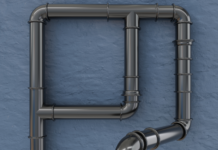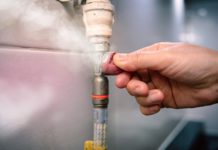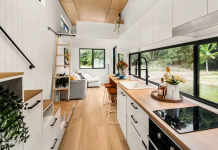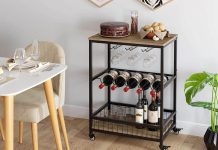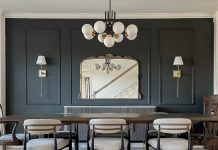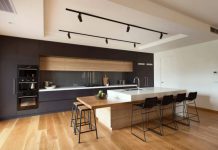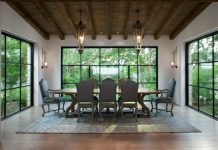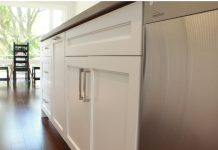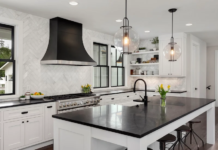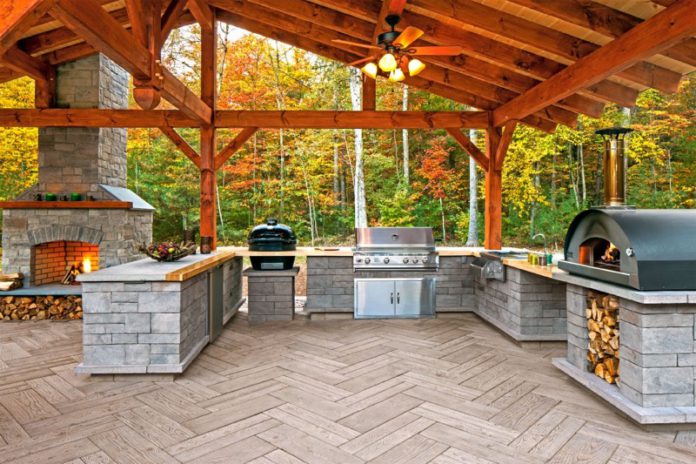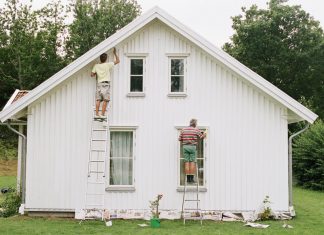Outdoor kitchens have evolved from simple grilling spots to sophisticated entertainment areas, complete with state-of-the-art appliances and, increasingly, the warm allure of fireplaces. Adding a fireplace not only enhances the ambiance but also extends the utility of outdoor kitchens into the chillier seasons. Below, we delve deeper into the types of fireplaces that can complement your outdoor kitchen and share essential maintenance tips to ensure your fireplace remains a beacon of warmth and enjoyment for years to come.
Elevating Spaces: Types of Outdoor Kitchen Fireplaces
The choice of fireplace for your outdoor kitchen can significantly influence the atmosphere and functionality of your outdoor living area. Each type offers unique benefits and considerations:
Wood-Burning Fireplaces
These fireplaces provide a traditional and authentic experience, creating a rustic ambiance with the unmistakable aroma and sound of crackling wood. Ideal for those who appreciate the ritual of building and tending to a fire, wood-burning fireplaces require a chimney and adequate ventilation, demanding more intensive installation and maintenance but offering an unmatched sensory experience.
Gas Fireplaces
For convenience and ease of use, gas fireplaces are unparalleled. They can be ignited instantly with the turn of a knob, offering immediate warmth without the need for firewood or extensive cleanup. Available in a variety of designs, gas fireplaces can seamlessly integrate into any outdoor kitchen style, from modern to traditional. They require access to a gas line and periodic maintenance to ensure safe and efficient operation.
Electric Fireplaces
Electric fireplaces are the epitome of convenience and safety, making them suitable for families and spaces where venting poses a challenge. They can be installed virtually anywhere and offer adjustable heat settings and even flame effects without real fire, making them the safest option. Although they lack the authenticity of real flames, electric fireplaces are an excellent choice for those seeking ease of installation and minimal maintenance.
Benefits of Adding a Fireplace to Your Outdoor Kitchen
- Extended Use: One of the main advantages of having a fireplace in your outdoor kitchen is the ability to use the space throughout the year. Even in colder weather, a fireplace provides enough warmth to make outdoor dining and cooking comfortable.
- Ambiance: A fireplace adds a unique ambiance to your outdoor kitchen. The crackling sound of burning wood and the soft glow of the flames create a cozy and inviting atmosphere that’s perfect for relaxing evenings.
- Increased Property Value: Outdoor kitchens and fireplaces are highly sought-after features that can significantly increase the value of your home. They’re seen as luxurious additions that offer both aesthetic appeal and functional benefits.
Design Considerations
- Location: The fireplace should be situated in a way that complements the layout of your outdoor kitchen while considering safety and wind direction. Ensure it’s positioned away from any flammable materials and structures.
- Materials: Choose materials that match or complement your outdoor kitchen’s design. Natural stone, brick, and stucco are popular choices that blend well with outdoor environments and are durable enough to withstand the elements.
- Seating: Incorporate comfortable seating around the fireplace to create a welcoming gathering area. Built-in benches, patio sets, and outdoor sofas are great options that encourage relaxation and conversation.
Ensuring Longevity: Maintenance Tips for Outdoor Fireplaces
Regular maintenance is crucial to ensure your outdoor fireplace continues to provide warmth and ambiance for many seasons. Here are some tips to keep your fireplace in top condition:
Regular Cleaning and Inspection
- Wood-Burning Fireplaces: Routinely remove ash and debris to prevent clogging and ensure efficient airflow. Inspect the chimney and firebox for cracks or signs of wear that could compromise safety.
- Gas Fireplaces: Check gas lines and connections annually for leaks or damage. Clean the burner and control compartment to prevent blockages that could affect flame quality.
- Electric Fireplaces: Dust and clean the heating element and fan to maintain optimal performance. Regularly check electrical connections and cords for signs of damage or wear.
Preventive Measures
- Safety First: Regardless of the type, always place a fire extinguisher nearby and ensure your fireplace is installed with adequate clearance from flammable materials and structures.
- Weather Protection: Use waterproof covers to shield your fireplace from rain, snow, and debris when not in use, especially in regions prone to harsh weather conditions.
- Professional Servicing: Annually, have a professional inspect and service your fireplace to address any potential issues and ensure it operates safely and efficiently. This is particularly important for wood-burning and gas fireplaces, which can develop complex issues over time.
Conclusion
Incorporating a fireplace into your outdoor kitchen not only enhances the aesthetic appeal of your outdoor space but also increases its functionality, allowing you to enjoy your backyard year-round. Whether you opt for a wood-burning, gas, or electric fireplace, consider the design and maintenance aspects to ensure your outdoor kitchen remains a warm, inviting, and safe space for all to enjoy. With careful planning and the right design choices, your outdoor kitchen with a fireplace can become the heart of your home’s outdoor living space.


